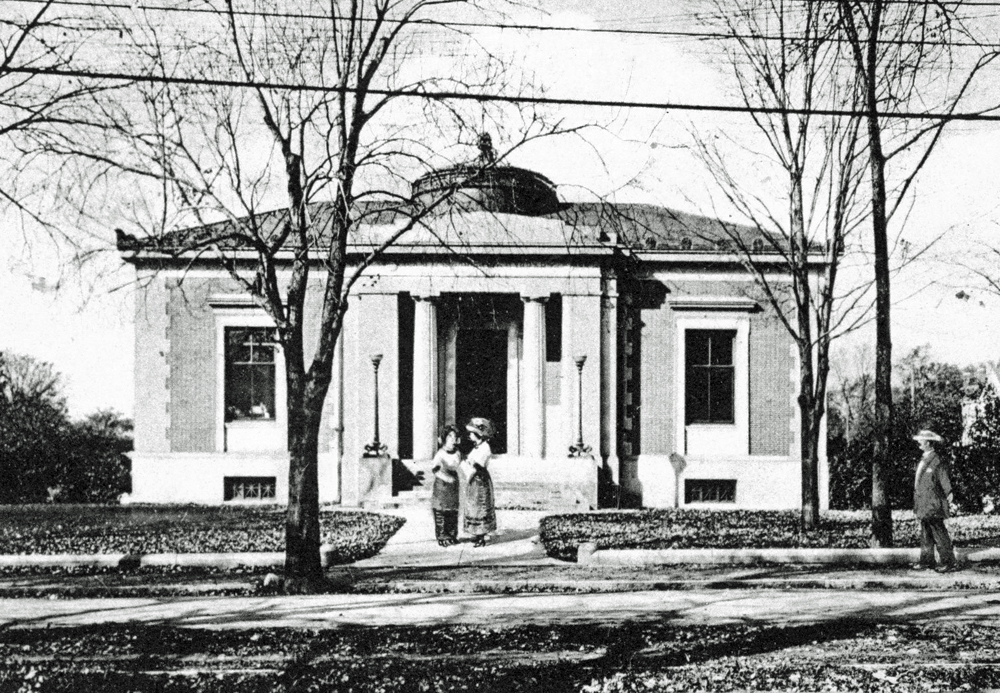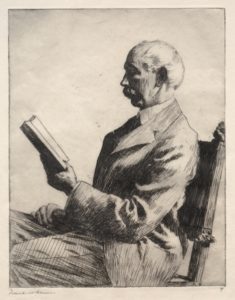Canton’s True Tales: More Than Books
By George T. Comeau
A postcard image of the Canton Public Library taken soon after it opened in 1902 (Collection of the author)
Augustus Hemenway Jr. stepped from his electric car as his driver waited patiently. Walking up Washington Street in the shadow of Memorial Hall, Hemenway surveyed the two houses he had only recently purchased. The houses were quite old and sat on a small hill at the intersection of Sherman and Washington streets. It was here that Hemenway decided he would build a grand public edifice. Hemenway would build a library for the town of Canton and in doing so, he would be a benefactor of an educational and cultural institution that still thrives today.
To step back into the Canton of 1901, it must have been an amazing project to undertake. Libraries were being built all across the commonwealth. Canton had a small reading room inside Memorial Hall, and it was never quite big enough to serve the town properly. It would take large sums of money to build a public library, and while the public need was great, the tax base did not support the construction cost.
It would take a large benefactor to support the building of a library. After all, Andrew Carnegie had been well on his path of donating more than $60 million for the construction of public libraries all across America — mostly in cities and towns that were willing to adopt a funding formula and provide for the land and upkeep of the new building and staff. Carnegie’s grants were very large for their time and his library philanthropy is one of the largest philanthropic activities, by value, in history. Small communities received grants of $10,000 that enabled them to build large libraries that immediately became significant landmarks across the landscape. In all, Carnegie endowed 2,509 libraries as part of his mission of giving.
In Canton, Hemenway knew full well the benefits of a solid education. Well educated himself, Hemenway graduated from Harvard in 1875. Already wealthy as a result of a vast inheritance, he donated a large gymnasium bearing his name which was considered one of the finest in the world at that time. Hemenway’s philanthropy touched many major Boston institutions, including the Museum of Fine Arts, Massachusetts Eye & Ear Infirmary and MIT, to name just a few. The vast land at Blue Hills was a gift from Hemenway to the commonwealth.
Yet it was not just money that Hemenway provided; he also gave of his time. Summers were spent in his large estate house, which is still standing on Green Street here in Canton. Not confined to his forests and fields, instead Hemenway became an active participant in local government. Hemenway served as a representative to the legislature for Milton and Canton in 1890 and 1891. And two institutions gained the strength of an association with Hemenway: the Canton School Committee and the Canton Public Library. Hemenway served on both boards and strengthened the town immeasurably. Two schools were built with Hemenway money. The Ponkapoag School and the Hemenway School were significant additions to the system as we entered the 20th century.
So generous to the teachers of Canton was Hemenway that in 1893 he took every schoolteacher in town, at his expense, to the Columbia World’s Fair. The cost to take the 19 teachers was the equivalent of $110,000 today. The papers swooned over the idea and took a crack and a swipe at the teachers, observing, “It will undoubtedly be necessary for somebody to go along who can keep this party of young women together, for some of them are very lively and of abundant animal spirits, while two at least are reported to be extraordinarily handsome.” My my!
There has been a long and iterative history of having a library in Canton. Not always public, and sometimes private, the history of the library began in 1766. Elijah Dunbar, an eminent citizen, organized a “library company” and would purchase books of interest in Boston and loan them from his home on Chapman Street. Each year in November there was an annual meeting of the proprietors of this library. Eventually this institution became known as the “Canton Social Library.” Books were loaned and gathered, and men got together to discuss the acquisitions and by 1835 the library contained all of the books that were part of the Dunbar collection. From 1833 until at least the late 1860s it was open every Sunday.
At the same time and in tandem, there was an institution called the Canton Lyceum. Marketed as “this school for grown folk,” the Lyceum was founded in 1828. Early lectures covered scientific and philosophical topics. They also collected books, and much of their material became part of the local library, as did that of the Ladies’ Social Circle of the First Parish. So, at one time there were a handful of libraries in Canton, all connected to memberships that loaned books to the citizenry. A movement was afoot in America to establish “free and open to all” public libraries. In April 1875, the various libraries came under the umbrella of the town. This was truly the establishment of the modern library we know today.
A board of trustees was elected and on June 6, 1875, the public library opened to all residents. Originally located in Wentworth Hall, they were moved to the Amory Building — still standing — on Church Street. When Memorial Hall opened in 1877, there were small reading rooms built as part of the interior of the first floor. It soon became apparent that more space was needed. By 1898 the library held more than 9,000 books with a circulation of close to 20,000 volumes a year. By 1900, Augustus Hemenway decided he would build a new and lasting building.
It was indeed built to last. Constructed at a cost of $70,000 and personally managed and financed by Hemenway, it was the finest in the county. The new building was constructed of Indiana limestone and Somerville hard brick. Originally the plan called for the names of prominent educators to be inscribed on the edifice. For some reason, that adornment never happened. What did happen was a temple to learning. The two main columns of limestone each weigh six and a half tons. The steps leading to the street from the front door are of limestone 21 feet wide with buttresses weighing 10 tons each. The building boasted marble floors and a soaring glass dome. The reading rooms had gorgeous fireplaces, one in French limestone and the other in Sienna marble. Glass floors in the stacks were accessed by a wrought-iron circular stairway. When it was completed, Hemenway signed the deed over to the town of Canton. It was state of the art and would stand the test of time to this day. It was simply amazing and still remains so.
The point is that the library in Canton is an ever-evolving institution that meets the needs of the community as it has since Dunbar began lending books in 1766. Each generation places its mark. And that is true again today. We have become both the benefactors and the beneficiaries of this most amazing place. As you read this story, dozens of volunteers have been working for months preparing for the Bank of Canton Technology Gala. The story is less about the building and more about the hundreds of community events and programs that take place in this space. The gala is simply the present community moving us forward and raising funds for technology and the library’s Maker Space. The money raised will help young and old remain competitive and exposed to a world of new ideas and tools. There is no doubt that Hemenway would be proud.
The Bank of Canton Technology Gala will be held on Saturday, November 23, at 7 p.m. at the Canton Public Library. See the datebook on page 15 for more event details.
Short URL: https://www.thecantoncitizen.com/?p=62001











